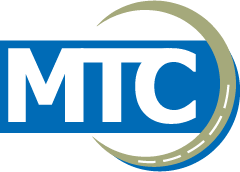Researchers
Ron McGarvey
Charles Nemmers
About the research
Striping operations generate a significant workload for state department of transportation (DOT) maintenance operations, including Missouri’s (MoDOT), which co-sponsored this project. The requirement for each striping crew to replenish its stock of paint and other consumable items from a bulk storage facility, along with the necessity to make several passes on most of the routes to stripe all of the lines on each road, can lead to deadhead miles that striping crew vehicles must travel while not actively applying pavement markings. These deadhead miles generate extra travel, wasted time, and vehicle wear.
The goal of this project was to develop a decision-support tool that utilizes optimization models to increase the efficiency of striping operations. This project addressed the scheduling of striping operations for a subset of MoDOT roads, those located in the Central District of Missouri, with a focus on minimizing deadhead miles. A computer program was developed for scheduling and routing road striping operations.
The research detailed through this project provides an optimization-based approach to determining a striping schedule that minimizes deadhead miles. Despite the fact that some factors remain unrepresented in the model (e.g., highway ramps that require striping), the current results of our model can be used to help MoDOT more quickly calculate a striping schedule and dynamically respond to unexpected conditions, such as schedule disruptions that occur (e.g., chip seal operations that were not completed on the scheduled date).
Even though MoDOT does not have records to compare and evaluate the current versus the proposed system, the advantage of implementing genetic algorithm (GA) techniques is apparent in alleviating the time and effort to develop a striping schedule.
This model provides an ability to significantly eliminate the effort necessary to produce the striping schedule as well as test what-if scenarios to examine the impact of changing resource levels, policies, etc.
Deadhead mile inefficiencies are manifested not only in additional, unnecessary miles traveled by striping crews, but also in crew and equipment capacity. Were a more-efficient utilization of road striping equipment possible, MoDOT could potentially reduce costs by decreasing its inventory of road striping assets without reducing the frequency with which it reapplies pavement markings to Missouri highways. In this regard, the what-if capabilities of our model could be useful beyond the creation of striping operations schedules.
In operations network optimization terms, the research involved our modification of what is called the “rural postman problem” to satisfy the conditions of the “slow-moving multi-pass postman problem with overnighting.” This constituted the formulation of a logistics model absent from the literature. As such, this formulation could be useful in the evaluation of other systems.
The focus with this project was on how increasing efficiency in striping operations represents a substantial opportunity for MoDOT and other state DOTs to reduce their annual expenses.
Funding Sources:
Midwest Transportation Center
Missouri Department of Transportation ($60,000.00)
USDOT/OST-R ($60,000.00)
Total: $120,000.00
Contract Number: DTRT13-G-UTC37
